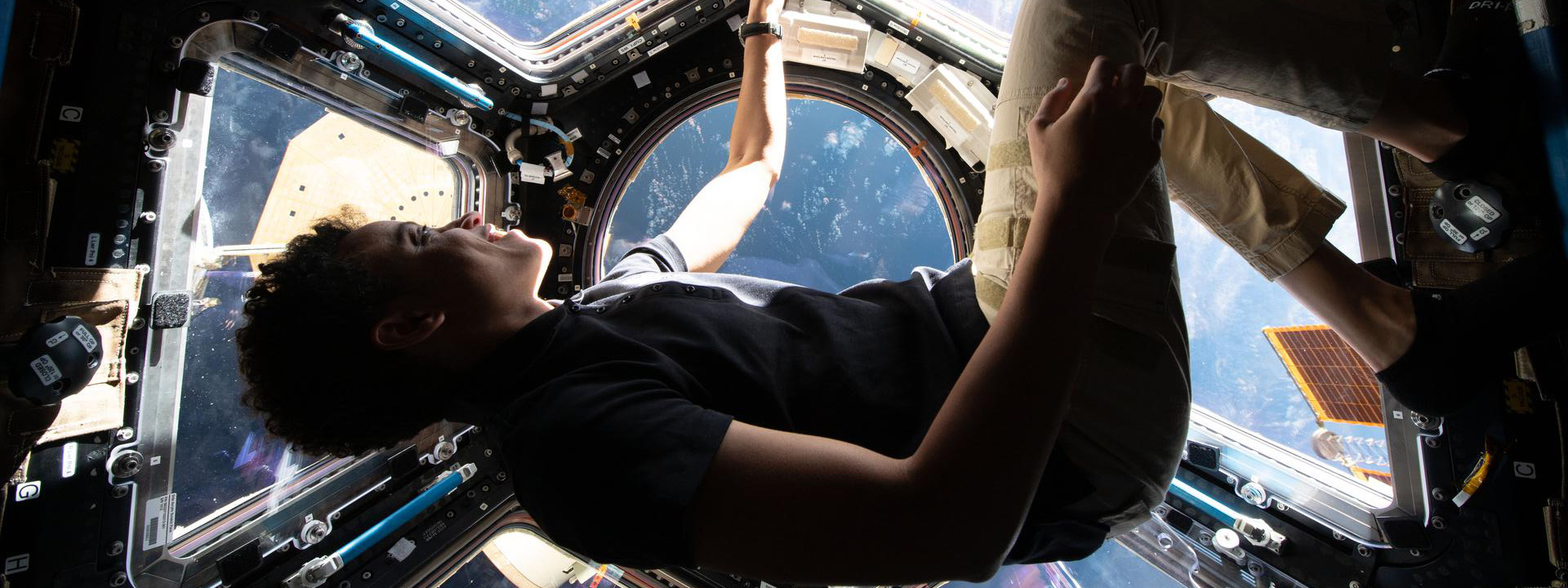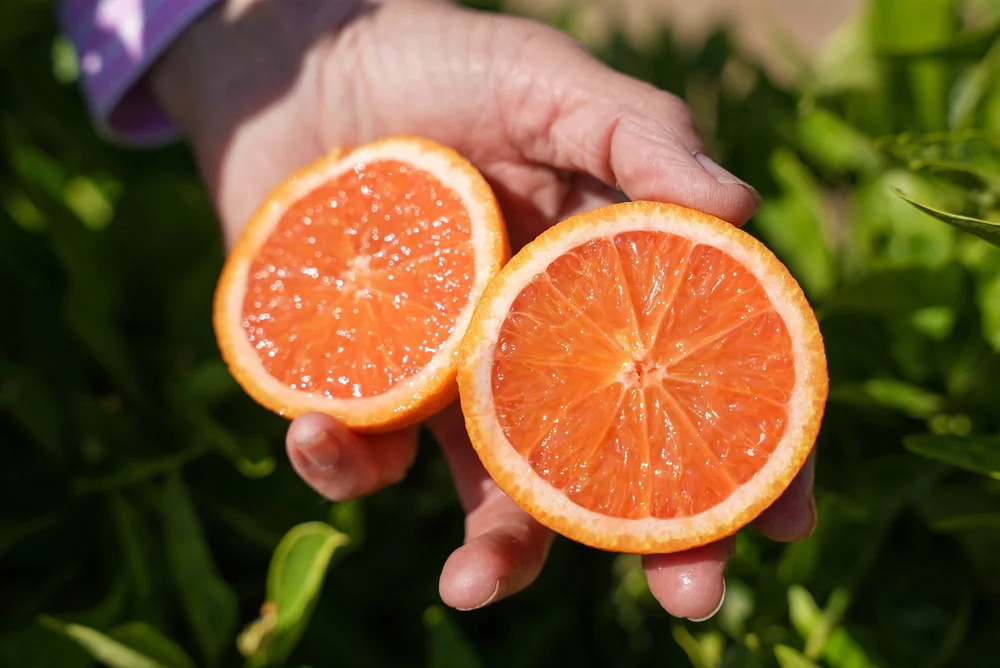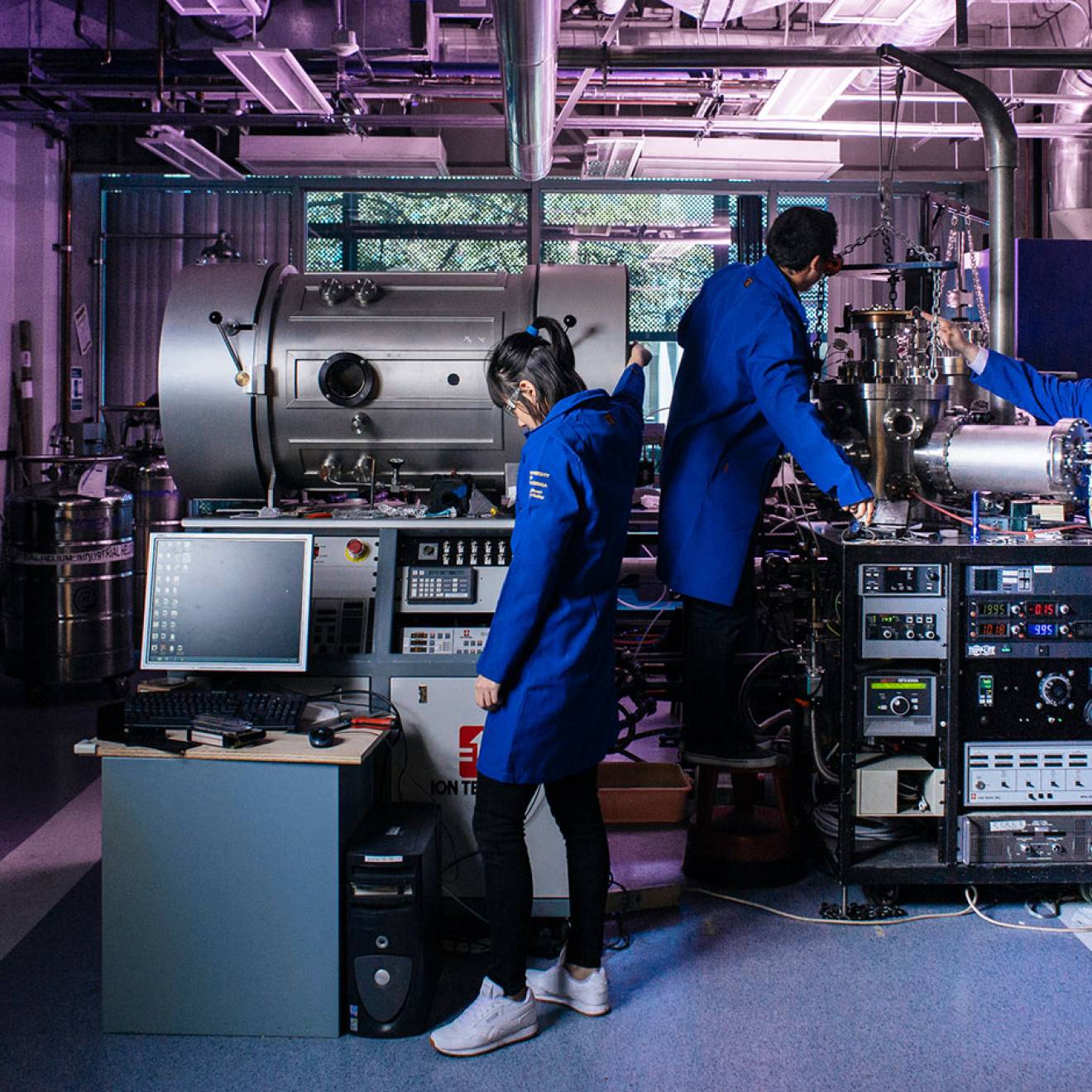Sally Ride spent six years getting ready to go to space. She mastered open water survival and the minute complexities of the spaceship control panel, flew fighter jets with the windows blacked out and aced mind games while smushed against the wall of a giant spinning centrifuge.
But none of this could have prepared her to keep a straight face when NASA engineers asked her how many tampons she’d need for her week-long mission: Would one hundred suffice?
"That,” she reportedly replied, “would not be the right number."
Ride was among the six women who broke NASA's astronaut gender barrier in 1978. These women shared the pressures, risks and thrills of their high-flying careers with their male colleagues; they also endured ignorance, skepticism and outright sexism en route to proving that women could do the job.
Once the question of the tampons was settled, Ride became the first American woman in space on June 18, 1983. (Russians Valentina Tereshkova and Svetlana Savitskaya were first and second overall.) She would eventually spend nearly 350 hours in orbit during two missions.
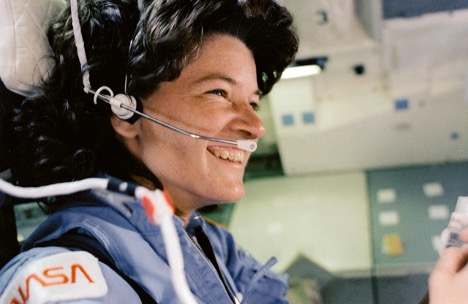
After NASA, Ride joined the faculty at UC San Diego, where she taught physics and studied electromagnetism. She retired from UC San Diego in 2007 and died of cancer in 2012 at 61.
“Sally was an inspiration to countless women,” said retired astronaut Pam Melroy at an event celebrating the 40th anniversary of Ride’s history-making flight last summer. “The girls and young women of that era saw a woman breaking the ultimate glass ceiling. She was more than just history. She was one of us, and she was all of us.”
An elite few of those girls and young women eventually made their own journeys to space. And of those, a considerable share followed Ride’s path to the University of California: of the 92 women who’ve ever been to space, 13 of them have studied or taught at UC, and NASA's latest class of astronauts includes one woman UC alum.
We’re celebrating far-out women of all kinds this Women’s History Month. Read on to learn more about UC’s spacefaring leaders.
Kathryn Sullivan
UCLA alum and NASA astronaut Jessica Watkins aboard the International Space Station.
UC Santa Cruz Class of 1973
First spaceflight: October 5, 1984
"No one's promising you a primrose path. You know, you're gonna have your setbacks, you're gonna have to persist and persevere. You're going to have to fight back sometimes. But the door is at least ajar — it's not wide open, but you can make your way through it." (From 2020)
Kathryn Sullivan became the first American woman to walk in space on October 11, 1984. During a tricky three-hour maneuver, she and a teammate piloted a system designed to refuel satellites in orbit. On her second mission, she helped launch the Hubble Space Telescope.
Sullivan earned an undergraduate degree in earth science from UC Santa Cruz in 1973, an early step on a lifelong journey of exploration. After NASA, she served as chief scientist for the National Oceanic and Atmospheric Administration. And she’s still putting up records: In 2020 she descended nearly 36,000 feet into the Pacific Ocean to the Challenger Deep, becoming the first woman to visit the ocean’s deepest spot.
More from UC Santa Cruz: Alumna Kathryn Sullivan enshrined in the National Aviation Hall of Fame
Anna Lee Fisher
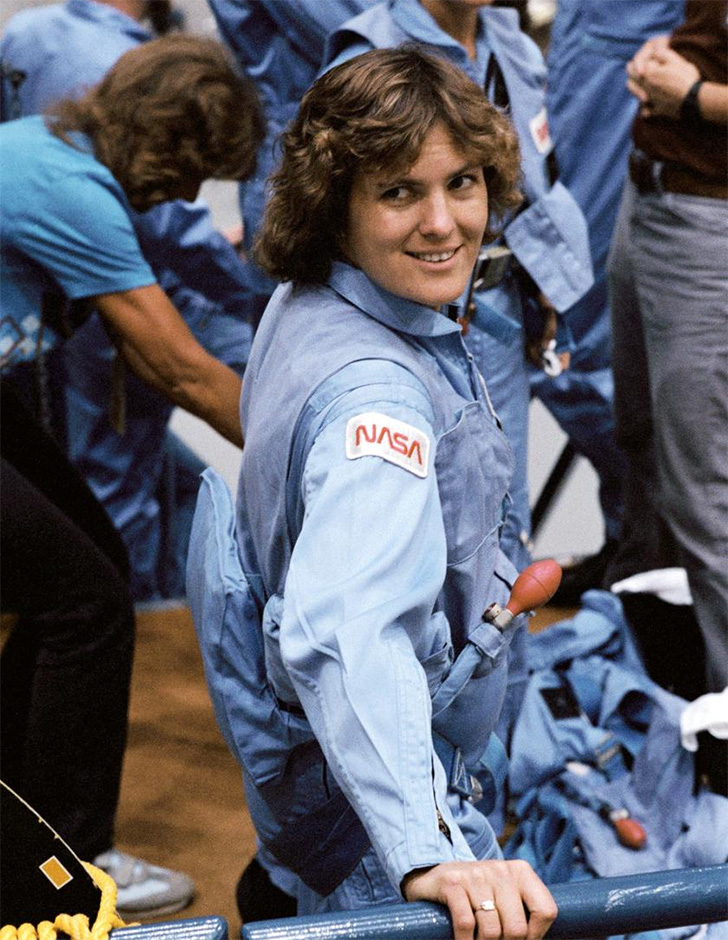
Kathryn Sullivan prepares for launch day at Johnson Space Center in 1984.
UCLA Class of 1971, UCLA medical degree 1976, UCLA master’s of science 1987
First spaceflight: November 8, 1984
"We are all astronauts on the spaceship earth ... let's all take care of our ship and each other, just as space shuttle and space station crews do." (From 2019)
Anna Fisher was partway through her residency in emergency medicine when she joined NASA’s Astronaut Corps in 1978, so she knew a thing or two about keeping calm under pressure. She’d need every ounce of that composure during her first space mission, when the crew discovered that the satellite they were trying to retrieve with a robotic arm didn’t fit a clamp that was supposed to attach to it. So they improvised: a crew member stood on the robotic arm and Fisher maneuvered the arm into position so her teammate could grab the satellite with his hands.
Fisher’s first spaceflight came 14 months after she gave birth, making her the first mom in space. (She reportedly took to reminding journalists that several of her male crewmates were also leaving children at home.) In what little spare time she had ahead of her flight, she designed the patch her crew would wear during their mission. It had six stars: one for each of the five astronauts, and a sixth to represent her baby daughter.
More from UCLA: Some working moms love their commute.
Margaret Rhea Seddon
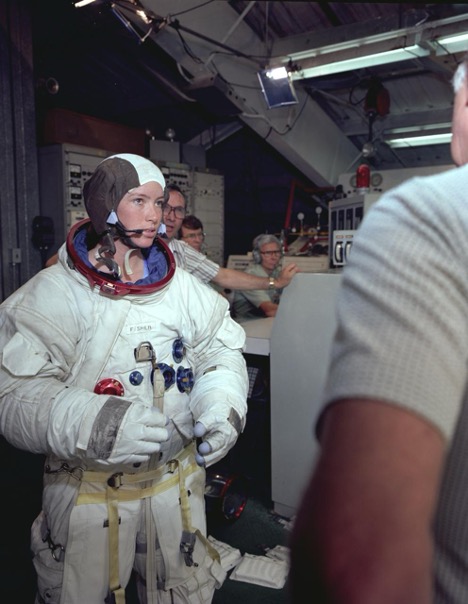
Anna Fisher suits up to practice swapping out instruments on a mockup of the Hubble Space Telescope in 1980.
UC Berkeley Class of 1970
First spaceflight: April 12, 1985
“The fullness of my life had brought me to this moment. All the unlikely roads taken, the risks addressed, the difficulties overcome had led to this. The ride up the clanking rusty elevator which had withstood the blast of Apollo and earlier Shuttle flights would be my first upward push of that day … We would sit atop the harnessed bomb until its fuse was lit.” (From 2016)
Margaret Rhea Seddon enrolled at UC Berkeley in 1965, just as the campus was sailing headlong into the turbulent Free Speech era. In a 2021 story in California magazine, she remembered “tear gas raining down from police helicopters” and “National Guard troops in riot gear.” But Berkeley was as eye-opening as it was harrowing: “New ways of thinking were developing. It was becoming more acceptable for women to plan careers, even unconventional ones.”
Seddon was already a surgeon by the time she joined NASA in 1978. On her first spaceflight in 1985, she used a bone saw from the onboard medical kit to jerry-rig a malfunctioning satellite.
More from UC Berkeley: Bears in Space: Shining the Spotlight on Five Interstellar Alumni
Tamara E. Jernigan
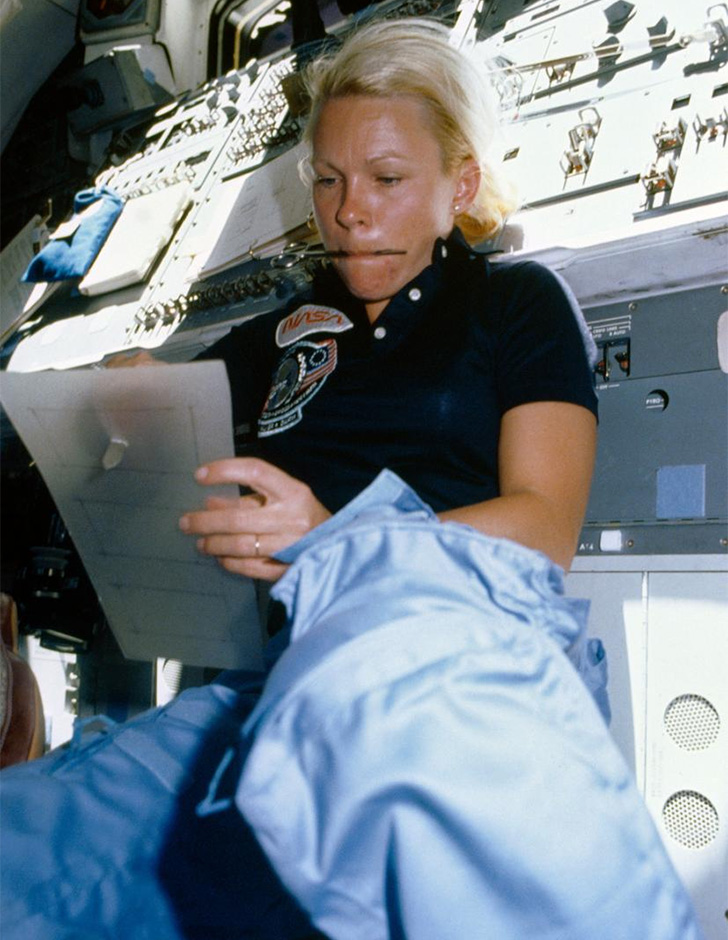
On her 1985 mission aboard the Discovery, Margaret Rhea Seddon hacks together a fly swatter-like snagging device to try to trip a stuck lever on the troubled Syncom-IV satellite.
UC Berkeley master’s in astronomy, 1985
First spaceflight: June 5, 1991
“I think an ability to ignore bad advice is important … there are so many more people who do encourage girls and young women in science and math that you have to listen to those voices and sort of ignore the others.” (From 2014)
Tamara Jernigan was ten years old when Neil Armstrong walked on the moon. She was one of countless people who gazed up at the sky during Armstrong’s 1969 mission and marveled at the knowledge that a human was up there looking back at Earth. That memory came rushing back to her years later: she was an undergraduate studying physics when she found out NASA was recruiting women with backgrounds in science, math, medicine and engineering to join the astronaut corps. “I thought, you know, someday I might have a shot,” she said.
Jernigan joined the Astronaut Corps in 1986 and took her first of five spaceflights in 1991. NASA dedicated that mission to studying biology, so Jernigan and her crew flew to space alongside a cage full of rodents and a tank of tiny jellyfish.
Jernigan left NASA in 2001 and made her way to UC’s Lawrence Livermore National Laboratory, where she worked for the duration of her career.
More from Livermore Lab: Meet Tammy Jernigan, Livermore scientist & former astronaut
Mary E. Weber
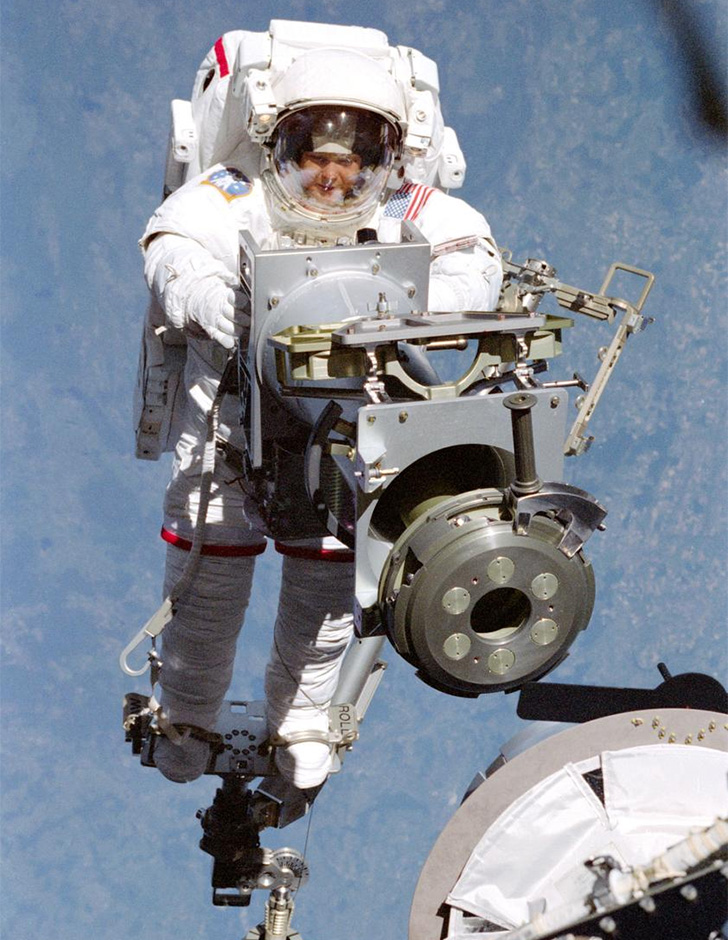
Tamara Jernigan operates a crane outside of the space shuttle Discovery, partway through a seven-hour spacewalk in 1999.
Ph.D. in physical chemistry from UC Berkeley in 1988
First spaceflight: July 13, 1995
“You just don't know what door is going to crack open and present a whole new world to you, spark a passion in you, and lead you down a path you never would’ve dreamed of or chosen to go down.” (From 2023)
Mary Weber’s ten year run at NASA was a study in versatility. During her first mission, she led a high-stakes satellite launch while carrying out research on colon cancer tissue. Her second flight came in 2000, while the International Space Station was under construction. She operated the robotic arm that guided spacewalking crewmembers safely over the station’s surface. While earthside, she helped advocate for NASA in Congress as the agency’s legislative affairs liaison.
When she’s not in space, she spends a lot of time as close to space as possible: she’s a legend in the niche world of skydiving, with 13 championship medals and a world record under her belt.
Tracy Caldwell Dyson
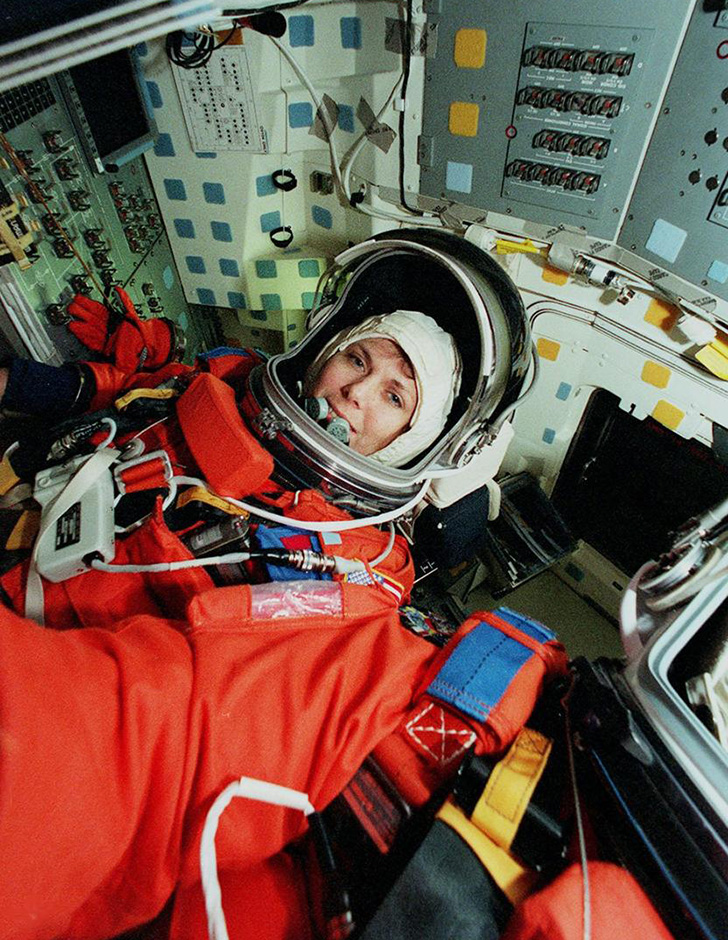
Mary Weber straps into her seat in the space shuttle Atlantis during a training exercise to simulate launch day in 2000.
Ph.D. in chemistry from UC Davis, Postdoc in atmospheric chemistry at UC Irvine
First spaceflight: August 8, 2007
“I knew I wanted to be an astronaut. I just didn’t know how to get there. But the key was, the pathway was, to do what I enjoy doing. And if I became an astronaut, well then, how blessed could I be? If I didn’t, then I was still going to do what I enjoy doing.” (From 2023)
It’s a big month for Tracy Caldwell Dyson. On March 21, if all goes accordingly, she’ll join three Russians and a Belarusian on a Soyuz ride to the International Space Station, with plans to remain in orbit for six months. While onboard, Caldwell Dyson will contribute to hundreds of ongoing experiments, like studying how fire behaves in space. It will be her third trip to space and her second six-month spell on the International Space Station.
Caldwell Dyson first thought about becoming an astronaut when she was 16, which is part of the reason she learned how to speak Russian while earning her Ph.D. from UC Davis. NASA has been her professional home for over 25 years, and she’s held dozens of disparate roles, from leading communications with astronauts at Mission Control to figuring out how to make Russian and American technology work together aboard the International Space Station.
More from UC Davis: Aggie Alum and Astronaut Tracy C. Dyson to Travel to Space for Third Time
Yi So-yeon
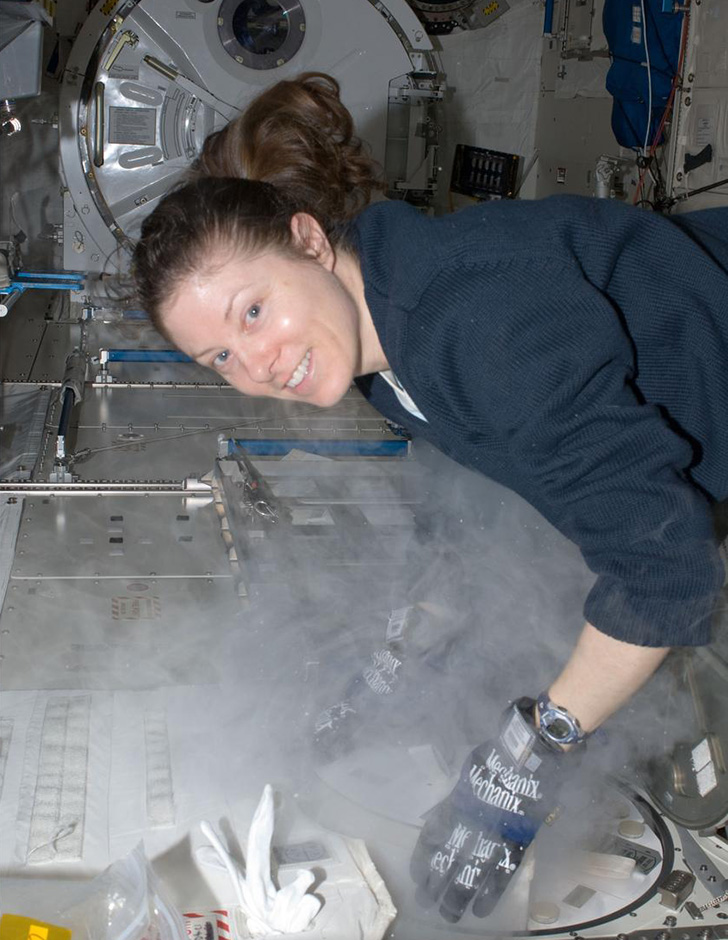
Tracy Caldwell Dyson pauses from her research on biological samples in the Minus Eighty Laboratory Freezer aboard the International Space Station in 2010.
M.B.A. from UC Berkeley
First spaceflight: April 8, 2008
“In Korea, we have a stereotype of the woman. So kind of dream woman to date or dream woman to be wife ... It’s a thin, pale, white skin, and little bit weak, doesn’t have any muscle at all, and emotional … I’m not a kind of dream woman at all.” (From 2017)
Yi So-yeon is the only person from Korea to have been to space. During her ten-day mission in 2008, Yi ran 18 experiments, including studying the behavioral and genomic traits of fruit flies in space. Her vessel docked at the International Space Station and picked up two returning astronauts, Peggy Whitson and Yuri Malenchenko. The capsule malfunctioned while returning to Earth and the crew endured ten Gs of force while hurtling through the atmosphere before landing hundreds of miles off-target.
The locals “were surprised when Yuri climbed out of the capsule,” Yi told Korean television. “They very well would have been, since a ball of fire fell from the sky and then a white object crawled out of it.” After retiring from the Korean Astronaut Program, Yi earned an M.B.A. from UC Berkeley and now lives outside of Seattle.
Megan McArthur
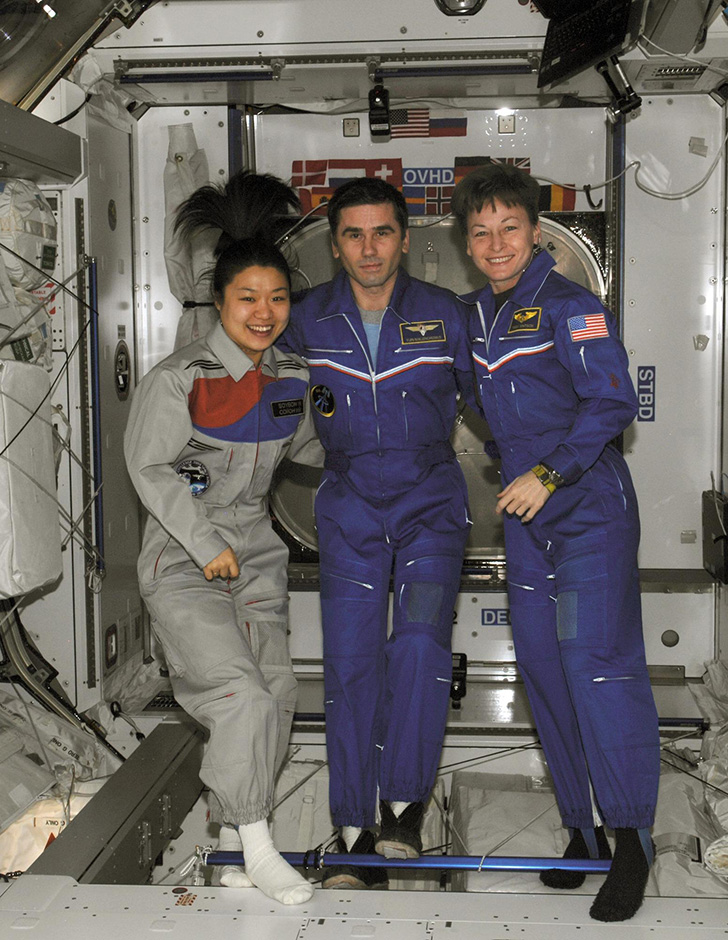
Yi So-Yeon, left, with NASA astronaut Peggy Whitson and Russian Federal Space Agency cosmonaut Yuri Malenchenko aboard the International Space Station in 2008.
B.S. in Aerospace Engineering from UCLA, Ph.D. in Oceanography from UC San Diego.
First spaceflight: May 11, 2009
“I saw lightning over the surface of the Earth. It was mesmerizing. It made me realize that this is a real living system … We talk about terraforming Mars, but seeing Earth makes you realize we need to conserve it first.” (From 2022)
During her doctoral research at Scripps Institution of Oceanography, Megan McArthur learned how to operate in remote, demanding environments. She ran experiments from ships in the middle of the ocean and led teams of scuba divers to the sea floor.
It was all good preparation for her first mission to space in 2009. During the 13-day trip aboard the space shuttle Atlantis, McArthur used a robotic arm to make the final planned upgrades to the Hubble Space Telescope. “Anytime a new discovery is made by Hubble I can say, ‘I did that; you’re welcome,’” she said.
McArthur returned to space in 2021, spending six months aboard the International Space Station.
More from UCLA: NASA Astronaut Megan McArthur ‘93 Shares Insights on Twice Journey to Space
Kathleen Rubins
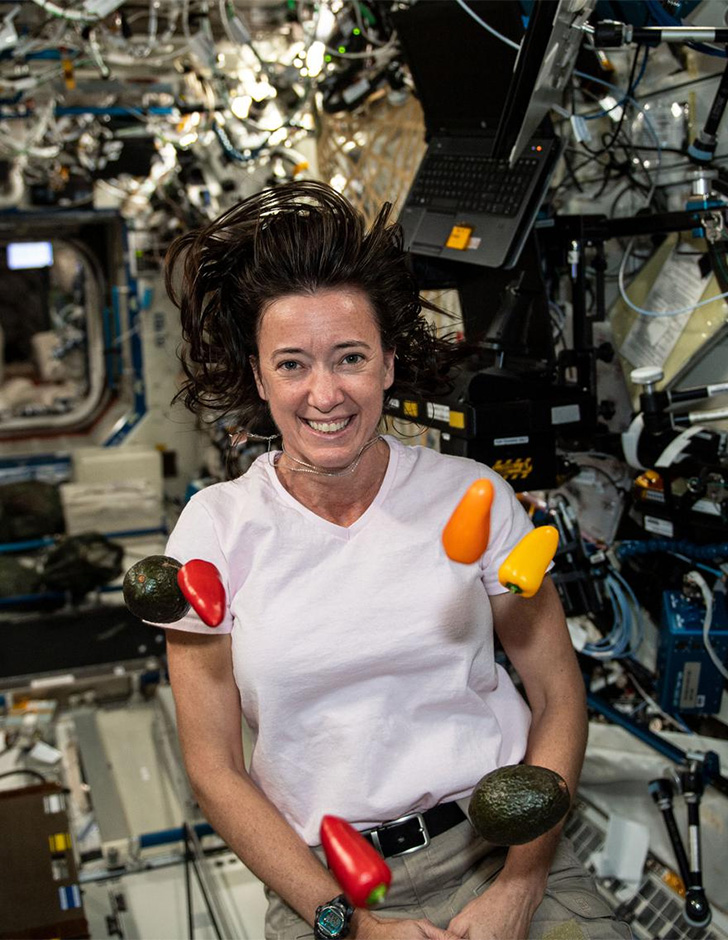
Megan McArthur wrangling meal prep aboard the International Space Station in 2021, after a resupply shuttle delivered fresh produce.
B.S. in molecular biology from UC San Diego
First spaceflight: July 6, 2016
“Space is both a place that is like, this far-off, almost fantastical thing that you think about and people dream about. But then on the other hand, to me, it’s a home.” (From 2020)
Kate Rubins has spent 300 days orbiting Earth, but her career has revolved around the small things. She studied HIV at UC San Diego and helped develop the first model of smallpox infection while earning her Ph.D. in cancer biology. During her 115-day stay aboard the International Space Station in 2016, she was the first person to sequence DNA in space. (On her return trip to the ISS in 2020, she voted.)
Now Rubins is one of three UC women alums on NASA’s Artemis team, as it prepares to bring the first woman and the first person of color to the moon. The team for this epic journey includes UC San Diego alum Jessica Meir and UCLA alum Jessica Watkins.
More from UC San Diego: Shooting for the moon
Jessica Meir
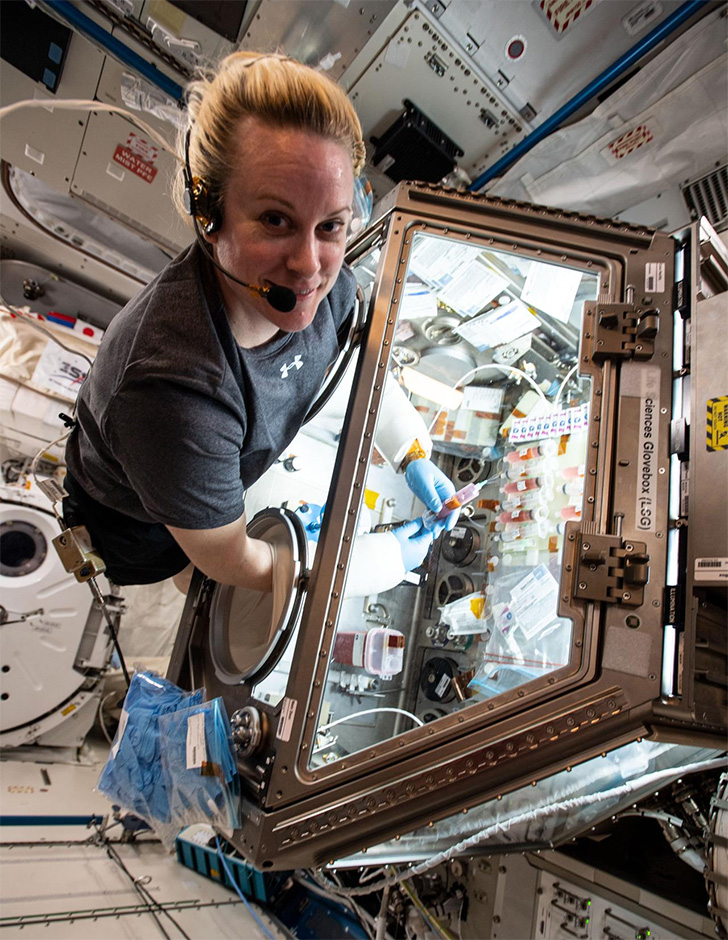
Kate Rubins works with heart tissue samples aboard the ISS for a study of space-caused cell and tissue abnormalities.
Ph.D. in marine biology from Scripps Institution of Oceanography at UC San Diego
First spaceflight: September 25, 2019
“One of the best parts about being in space is just the simple fact of living up there and floating all the time. Everything is so much more fun when you’re floating.” (From 2020)
While aboard the ISS in 2019, Meir and her crew ran daily experiments in biology, Earth science, physiology and technology. She and Christina Koch completed the first all-woman spacewalk. And in 2020, she was selected as one of eight members of NASA’s Artemis mission.
As members of the 18-person Artemis Team, Meir will help pave the way for NASA’s next lunar missions. The Artemis program aims to investigate more of the moon’s surface than ever before and will serve as a springboard for NASA’s next giant leap: exploring Mars.
More from UC San Diego: 5 questions with astronaut Jessica Meir
Jessica Watkins
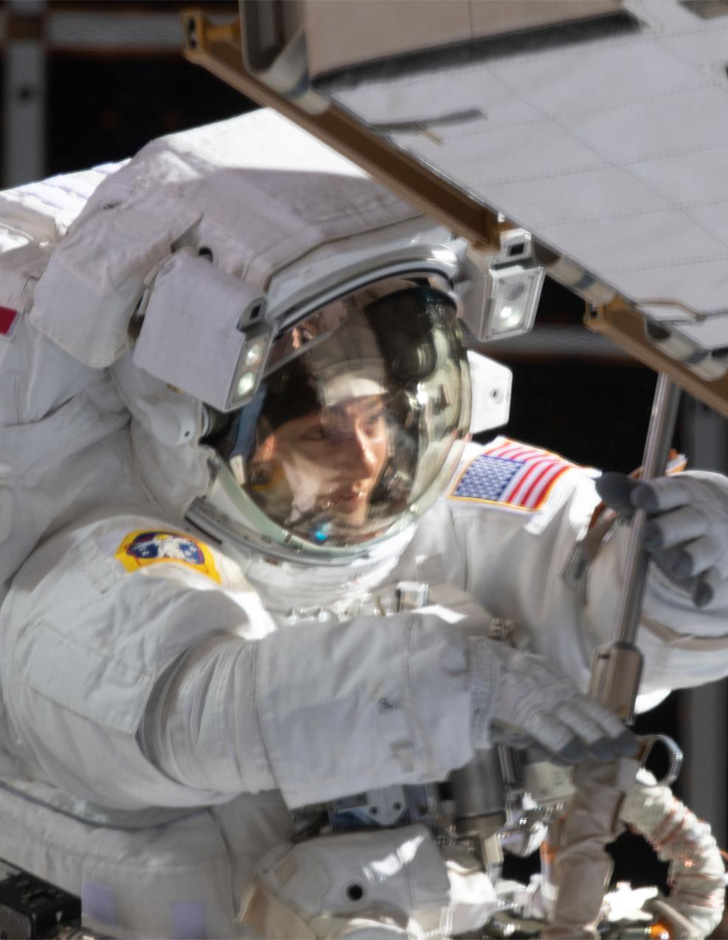
Jessica Meir installs new batteries to store power generated by the ISS's solar panels during the first all-woman spacewalk in 2020.
Ph.D. in geology from UCLA in 2015
First spaceflight: April 27, 2022
“I think it’s really just a tribute to the legacy of the Black women astronauts who have come before me, as well as to the exciting future ahead. Mentors have always been a force that have helped me determine my pathway ... I’m honored to return the favor.” (From 2022)
During her doctoral research in geology at UCLA, Jessica Watkins did field work in some of the most famous landscapes on earth, studying the forces that shaped dramatic sights like Yosemite Valley and the Grand Canyon. In 2022, she got a fresh perspective on these familiar sights when she joined the crew of the International Space Station for a six-month hitch.
Watkins, an expert in Martian and terrestrial geomorphology, is the first Black woman to crew the ISS, and she’s also on NASA’s crew of 18 Artemis astronauts. She participated in hundreds of studies during her 2022 mission, including researching how to grow food in space without using soil.
More from UCLA: Alumna Jessica Watkins reflects on her journey so far
Katya Echazarreta
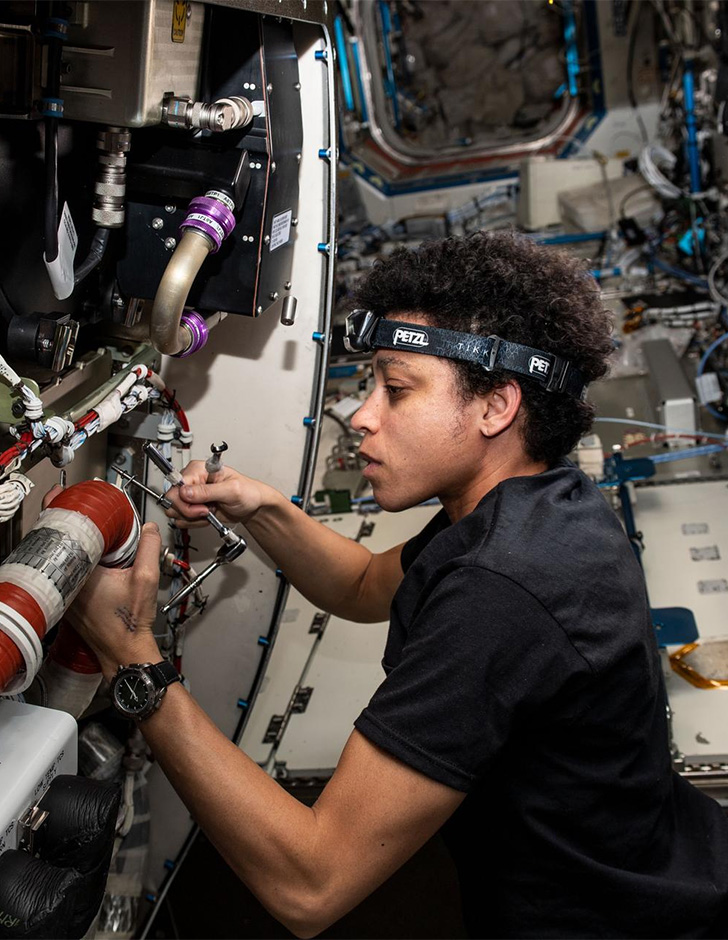
Jessica Watkins tinkers with the Major Constituents Analyzer, a life support device that maintains the balance of oxygen and carbon dioxide levels aboard the International Space Station, during her 2022 mission.
B.S. in electrical engineering from UCLA
First spaceflight: June 4, 2022
“Being able to do this for my community has meant so much to me, because I’m able to give them the gift of dreaming, the gift of hoping, the gift of feeling like this is really possible for someone like them.” (From 2022)
Katya Echazarreta can’t remember a time that she didn’t want to go to space. “For me, it’s just always been a constant,” she said in a 2022 profile, shortly after returning from the mission that made her the first Mexican-born woman in space. She beat out 7,000 other applicants to become the first Citizen Astronaut to go to space with the nonprofit Space for Humanity.
Echazaretta migrated with her family from Mexico to California when she was in grade school. She transferred to UCLA after three years at a California Community College, majoring in electrical engineering. Along the way she did an internship at NASA, and went to work for the agency after graduation, helping develop a spacecraft that will orbit Jupiter and study one of its moons, Europa.
Deniz Burnham
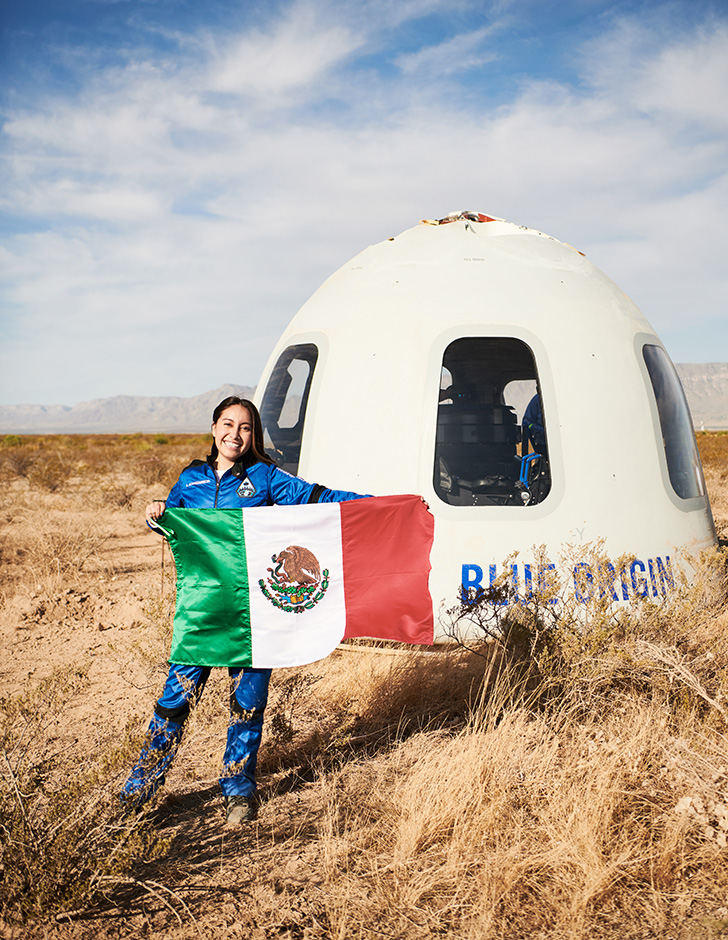
With her June 4, 2022, launch, Katya Echazaretta became the first Mexican-born women in space.
Bachelor’s degree in chemical engineering from UC San Diego in 2007
First spaceflight: stay tuned!
“It’s kind of surreal when you literally talk about something your whole life and then it happens. You’re just so, so grateful.” (from 2021)
Newly minted astronaut Deniz Burnham earned her wings last month as one of ten candidates to complete NASA’s two-year astronaut training. The recent graduates are awaiting their first space assignment, which could take them to the moon or even Mars.
Burnham received a degree in chemical engineering from UC San Diego and completed internships at NASA’s Ames Research Center while earning her graduated degree. She’s flown seaplanes, helicopters, paramotors, hang gliders, paragliders and sailplanes. A lieutenant in the U.S. Navy, Burnham previously spent a decade in the energy industry, working as an engineer in charge of remote drill rigs in Canada, Alaska and Texas.
More from UC San Diego: Next generation
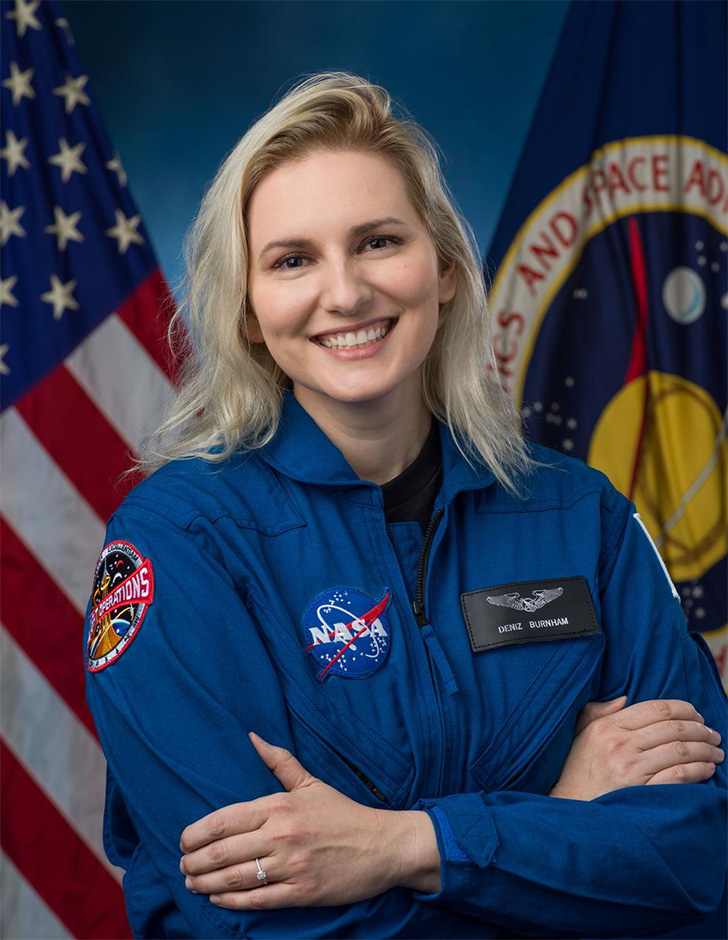
Deniz Burnham earned her astronaut wings last month.
